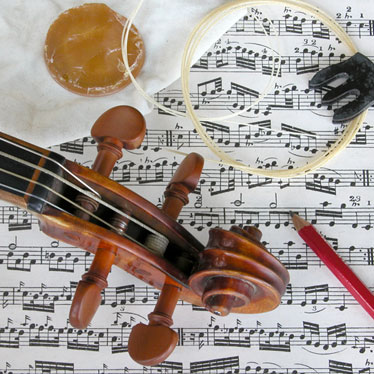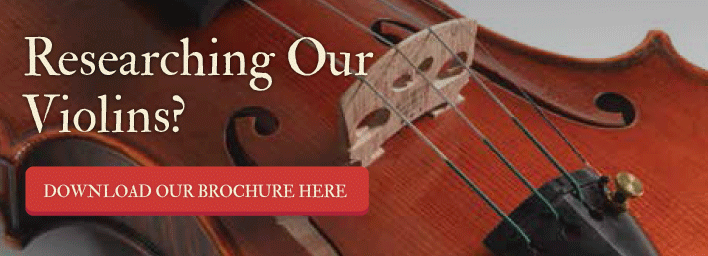Must-Have Accessories For A String Musician

Out of necessity, students who play string instruments require a number of accessories. Whether you’ve just started learning or you’ve been playing for a while, there is some “must have” equipment that will make your life easier. Knowing what accessories to include for your string instrument can mean the difference between success and failure. Keeping the following items close at hand will limit the natural frustrations that accompany the learning process.
Accessories for All String Musicians
Regardless of the bowed instrument you play, all string musicians need some specific tools. In addition to your instrument and hard case (which is essential), these accessories are vital:
- Good Rosin—Students generally get rosin with their instruments during the initial purchase, but it’s typically not the highest quality. A basic rule of thumb: if the rosin comes in a square package it is most likely of lower quality than those that come in a round or rectangular container. Don’t worry if you’ve been using a low quality rosin, just buy a higher grade as soon as possible. Take a look at the fun designs and high quality, pure pine rosin at Magic Rosin.
- Digital Chromatic Tuner/Metronome—The best way to ensure that your string instrument is always in tune (especially important for beginners) is to have a digital tuner on hand. There are a number of great models available and they generally cost from $8-$40. You can also download free tuner apps for your smart phone, that way you’ll have a back-up.
- Music Stand—This accessory is crucial for all string musicians, particularly students. Laying your sheet music on a desk and looking down at it enforces bad posture. And while that might not seem like a big deal, the injuries it can produce are serious. A good music stand will run you about $20-$30. Don’t forget to include a few large paper clips so that you can secure your music to the stand outdoors.
- Pencil—Not only is this important for lubricating the notches on your bridge from time to time, a pencil is necessary for making notes on your music.
- In-case Humidifier—This helps prevent your string instrument from drying out during winter months or dry seasons. By maintaining a consistent humidity, you prevent cracks and other related damages.
- Dry Cloth—Having a clean, dry cloth (microfiber is great) handy helps prevent rosin build up and any damage caused by the oils in your skin. Always wipe down your instrument after every playing session.
Intermediate and Seasoned Musicians
In addition to basic accessories, once you've been playing a while, upgrading your bow and strings can have a positive influence on your performance.
- Carbon Fiber Bow—Again, most instrument kits include a bow, but a carbon fiber bow offers a number of advantages over less expensive Brazil wood or aluminum bows. Composite bows are extremely durable and they won’t warp or be affected by climate changes. As far as expense, the cost for a composite bow begins at around $50 and goes into the nose bleed range with some models into the thousands. A high quality carbon composite bow costs around $150-$200.
- Quality Strings—You’ll never know the difference a great set of strings can have on your playing or the superior sound you can produce on your instrument until you’ve restrung it using different strings. Seasoned musicians should try Thomastik-Infeld’s Dominant or Peter Infeld for viola and violin, Versum or Spirocore for cello, or Belcanto for double bass, but there are plenty of others out there to use for experimentation.(Students should try Thomastik-Infeld’s Alphayue set.)
For Specific String Instruments
Different string instruments require different “must have” accessories. Depending on what instrument you play, you’ll need some additional equipment.
Violin/Viola:
- Chin rest pad and/or sponge—While some instructors disagree about this accessory, it can be invaluable for beginner students. Learning the correct posture requires consistency, and a chin rest fitted with a sponge can help decrease the discomfort. Your chin and shoulder rest most likely came standard with your instrument, but if not, get them to help maintain the correct playing position.
Cello/Double Bass:
- Case Wheels—Moving large instruments can be difficult. A set of case wheels or an instrument buggy will help reduce the strain on your back or the possibility of instrument damage. Many products allow you to use them with your instrument in or out of its case, they’re easy to steer and allow you to keep your endpin attached.
- Endpin Stop or Anchor—The tip on your endpin isn’t able to keep instruments from moving around as you play. An anchor or stop (usually attached to a chair for cellos) will give you extra stability while playing. For the double bass, you can purchase stops that stick to surfaces, or for a DIY solution you can purchase a rubber walker tip to size and fit it on the endpin.
Having the right accessories for your string instruments will make a big difference in your performance.


